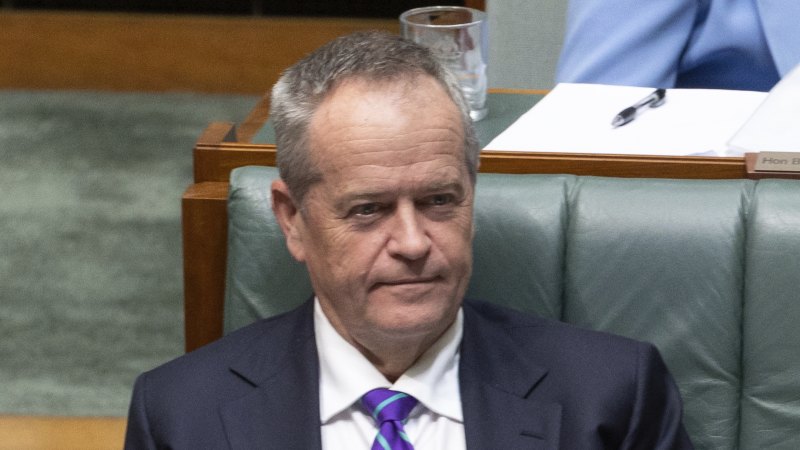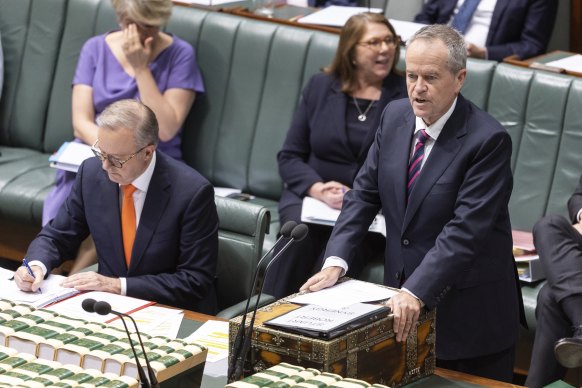Save articles for later
Add articles to your saved list and come back to them any time.
Blowouts in the National Disability Insurance Scheme’s bottom line will shrink by $15.3 billion in just four years, according to government modelling of its plans to extend the length of people’s support packages and increase oversight of how money is allocated and spent.
This will involve scrutinising the price limits set for different services claimed through the NDIS, which are the highest of all government schemes and can be more than three times the rate of Medicare rebates.
NDIS Minister Bill Shorten said on Thursday 70 per cent of participants were currently on plans that lasted 12 months or less.Credit: Alex Ellinghausen
Allied health professionals, such as dieticians, occupational therapists, physios, podiatrists and speech pathologists, can be paid up to $193.99 an hour on the NDIS, for example, compared to a standard Medicare rebate of $56 for similar services.
Tuesday’s budget showed the scheme has blown out by $32 million a day since the Coalition’s March budget last year, or about $978 million a month. The forward estimates say it will cost $55.9 billion by 2026-27, and it is now the federal government’s fastest-growing expense.
The government plans to spend a further $620 million over the next four years on five key measures that come under the headline of “improving the effectiveness and sustainability” of the NDIS.
Internal modelling reveals this is expected to pare back blowouts by $15.3 billion within the next four years, when an 8 per cent growth target, agreed upon by national cabinet, comes into effect.
The government says this will prevent the scheme’s annual cost rising to $97 billion within a decade: it is forecast to reduce growth by a further $59 billion after the target is in place, meaning a cumulative saving of $74 billion by 2023-24.
Modelling says the biggest saving on growth over the forward estimates, $7.2 billion, will come from helping participants manage their plans within budget over longer time frames.
NDIS Minister Bill Shorten said on Thursday 70 per cent of participants were currently on plans that lasted 12 months or less.
“That means everything’s about getting the plan done, getting the reports in, spending the money, making sure there’s nothing left so that you can get the same amount next year,” he said.
He said it also meant “paying for more reports to tell authorities that: ‘Yes, I still have Down syndrome’ or ‘Yes, I still have severe autism’.”
The government instead wants to move to three- or five-year plans that will increase certainty for participants, so they don’t rush to spend all their allocated funds by the end of each year.
This will also help the scheme’s bottom line by limiting the intervals at which plan budgets are reassessed, on average, to a higher rate.
For participants who have had three plans, the latest quarterly NDIS report shows average annual budgets increased from $41,800 for the first, to $50,000 for the second and $54,300 for the third.
The $73.4 million investment in better planning will also heighten accountability of plan managers, support co-ordinators and providers, the budget papers say. The government expects this to cut the scheme’s growth by 4 per cent.
Another $2.5 billion will be saved by bulk-buying assistive technology, such as wheelchairs, at discount prices through a new expert advisory panel akin to the Pharmaceutical Benefits Scheme that negotiates the country’s medicine prices.
That $29.3 million measure will also ensure services meet an evidence standard and that the NDIS pricing list – which has higher caps than other government schemes – is not distorting how much service providers charge patients.
There will be another $56 million spent on improving the decisions people make about supported independent living, amid concerns that some accommodation providers are extorting NDIS participants.
The NDIS plan in the federal budget, and projected impact
This could involve providing more flexibility for home modifications, so people don’t need to move into supported accommodation. That saving has been priced at $700 million.
The changes will be supported by a revamped National Disability Insurance Agency, which administers the scheme and will have its staff cap lifted from 4000 people. This quality measure is expected to save $3.1 billion over four years – or reduce growth by 1.6 per cent.
Shorten last month told the National Press Club the NDIS had lost its way and needed a “reboot” to ensure every dollar was being well spent.
The Coalition has indicated its support for measures that will make the NDIS, which serves 573,000 Australians and is growing daily, more financially sustainable.
But any moves are being closely scrutinised by critics, including the Greens, who are holding Labor to its promise of no cuts to the scheme and called for Shorten to produce the financial documents underscoring his plans to the Senate on Thursday.
“It is imperative that the government come clean and provide the evidence they are basing these cuts upon. Labor has already infringed upon the principle of co-design and [is] expecting disabled people to trust a secret document as reasonable grounds to do so,” Senator Jordon Steele-John said.
However, Shorten has been quick to emphasise the 8 per cent target is not a firm cap, nor a spending cut, as well as to promise any measure will be co-designed by people with a disability.
“Certainly all of the ideas that we have put [forward] have been stress-tested with the leadership of the [NDIS] review. They’ve been stress-tested with the agency and [chairman] Kurt Fearnley and the board of the NDIS,” he said on Thursday.
Cut through the noise of federal politics with news, views and expert analysis from Jacqueline Maley. Subscribers can sign up to our weekly Inside Politics newsletter here.
Most Viewed in Politics
From our partners
Source: Read Full Article

